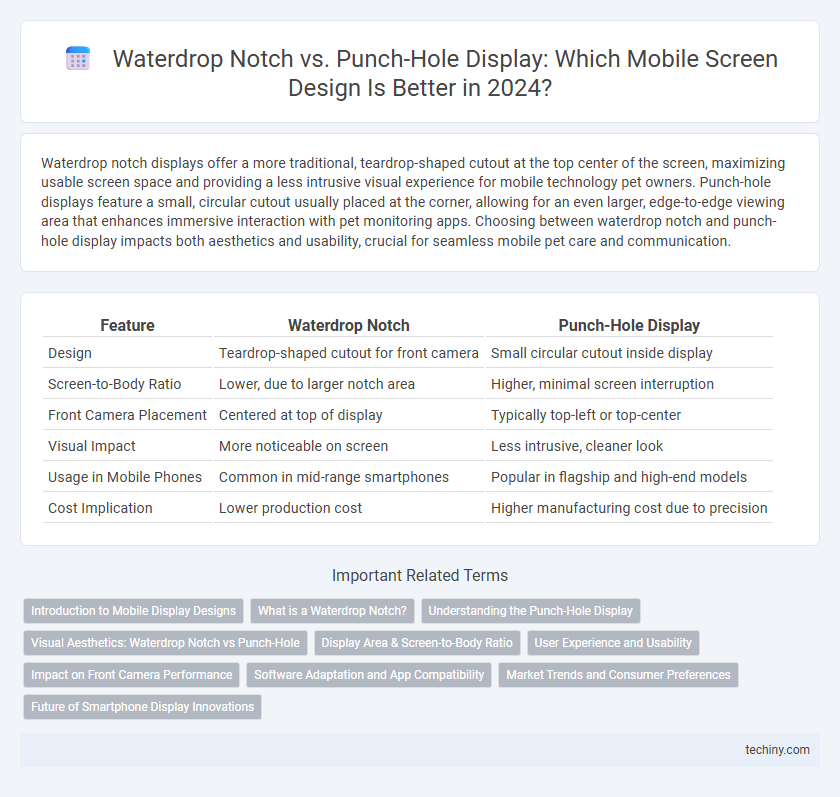Waterdrop notch displays offer a more traditional, teardrop-shaped cutout at the top center of the screen, maximizing usable screen space and providing a less intrusive visual experience for mobile technology pet owners. Punch-hole displays feature a small, circular cutout usually placed at the corner, allowing for an even larger, edge-to-edge viewing area that enhances immersive interaction with pet monitoring apps. Choosing between waterdrop notch and punch-hole display impacts both aesthetics and usability, crucial for seamless mobile pet care and communication.
Table of Comparison
| Feature | Waterdrop Notch | Punch-Hole Display |
|---|---|---|
| Design | Teardrop-shaped cutout for front camera | Small circular cutout inside display |
| Screen-to-Body Ratio | Lower, due to larger notch area | Higher, minimal screen interruption |
| Front Camera Placement | Centered at top of display | Typically top-left or top-center |
| Visual Impact | More noticeable on screen | Less intrusive, cleaner look |
| Usage in Mobile Phones | Common in mid-range smartphones | Popular in flagship and high-end models |
| Cost Implication | Lower production cost | Higher manufacturing cost due to precision |
Introduction to Mobile Display Designs
Waterdrop notch and punch-hole display designs represent innovative solutions to maximize screen real estate on smartphones by minimizing bezel size. The waterdrop notch features a small, rounded cutout at the top center of the screen, housing the front camera with minimal intrusion, while punch-hole displays embed the camera directly within the screen using a tiny circular cutout. These designs enhance immersive viewing experiences, contributing to modern mobile technology trends by balancing aesthetics and functional front-facing sensor placement.
What is a Waterdrop Notch?
A Waterdrop Notch is a small, rounded cutout at the top center of a smartphone screen designed to house the front camera while maximizing display area. This design minimizes bezel intrusion compared to traditional notches, offering a more immersive viewing experience. Waterdrop notches are commonly found in mid-range and budget smartphones, balancing aesthetics and functionality.
Understanding the Punch-Hole Display
The punch-hole display integrates the front camera within a small circular cutout, maximizing screen real estate and enhancing the immersive viewing experience. Unlike the Waterdrop Notch, which occupies more vertical space with a teardrop-shaped cutout, the punch-hole design offers a modern aesthetic and improved screen-to-body ratio. This technology is widely adopted in flagship smartphones for delivering a sleek, uninterrupted display while maintaining functionality.
Visual Aesthetics: Waterdrop Notch vs Punch-Hole
Waterdrop notch displays offer a smaller, teardrop-shaped cutout that maximizes screen real estate and provides a minimalist, less intrusive visual experience compared to punch-hole displays. Punch-hole displays feature a circular cutout typically positioned in a corner, balancing modern aesthetics with functional use of front camera space. Both designs impact visual aesthetics by influencing screen symmetry and immersive viewing, with waterdrop notches favoring subtlety and punch-holes supporting a futuristic look.
Display Area & Screen-to-Body Ratio
Waterdrop notch displays maximize screen-to-body ratio by minimizing bezel intrusion, offering up to 90% display area on modern smartphones, whereas punch-hole displays, while slightly reducing screen-to-body ratio to approximately 85-88%, provide a more discrete front camera placement. The waterdrop notch consumes a small, curved segment at the top center, allowing larger uninterrupted content viewing, ideal for immersive multimedia experiences. Punch-hole designs integrate the front camera within the display panel itself, maintaining an almost seamless screen surface but sacrificing marginally more usable display space due to the circular cutout.
User Experience and Usability
Waterdrop notch displays offer a minimal intrusion on screen real estate, enhancing video playback and gaming experiences by maximizing visible area. Punch-hole displays embed the front camera within the screen, providing a sleek aesthetic and allowing for larger notification and status bars, which improve user interaction. Users often prefer punch-hole designs for multitasking due to better integration with UI elements, while waterdrop notches may be favored for their simpler, less distracting shape.
Impact on Front Camera Performance
Waterdrop notch displays minimize bezel intrusion, allowing for larger camera sensors that enhance front camera performance with improved image clarity and low-light capabilities. Punch-hole displays integrate the front camera into a small cutout within the screen, often requiring smaller sensors that can limit lens size and reduce light intake, potentially affecting photo quality. Advances in sensor technology partially mitigate these limitations, but waterdrop notch designs generally offer superior front camera performance due to their larger, unobstructed sensor placement.
Software Adaptation and App Compatibility
Waterdrop notch displays offer straightforward software adaptation due to their smaller, symmetrical cutout, leading to higher app compatibility and fewer UI adjustments. Punch-hole displays present a more irregular screen interruption, requiring advanced software optimization to prevent content clipping and ensure seamless interaction across diverse applications. Developers prioritize dynamic layout adjustments and status bar modifications to accommodate these differing screen designs while maintaining consistent user experiences.
Market Trends and Consumer Preferences
Waterdrop notch displays have declined in popularity as punch-hole designs dominate the mobile technology market, offering a more immersive screen experience favored by consumers. Market trends reveal a strong preference for punch-hole displays due to their minimal screen intrusion, enhancing both aesthetics and usability in flagship smartphones. Consumer demand drives manufacturers to adopt punch-hole technology, reflecting a broader shift toward maximizing screen real estate and improving device ergonomics.
Future of Smartphone Display Innovations
Waterdrop notch and punch-hole displays represent key transitional designs in smartphone screen technology, offering increased screen-to-body ratios compared to traditional bezels. Future smartphone display innovations are expected to move beyond these cutouts toward under-display cameras and flexible OLED panels, enabling truly uninterrupted viewing experiences. Emerging technologies such as micro-LED and advanced sensor integration will further redefine the aesthetics and functionality of mobile displays.
Waterdrop Notch vs Punch-Hole Display Infographic

 techiny.com
techiny.com